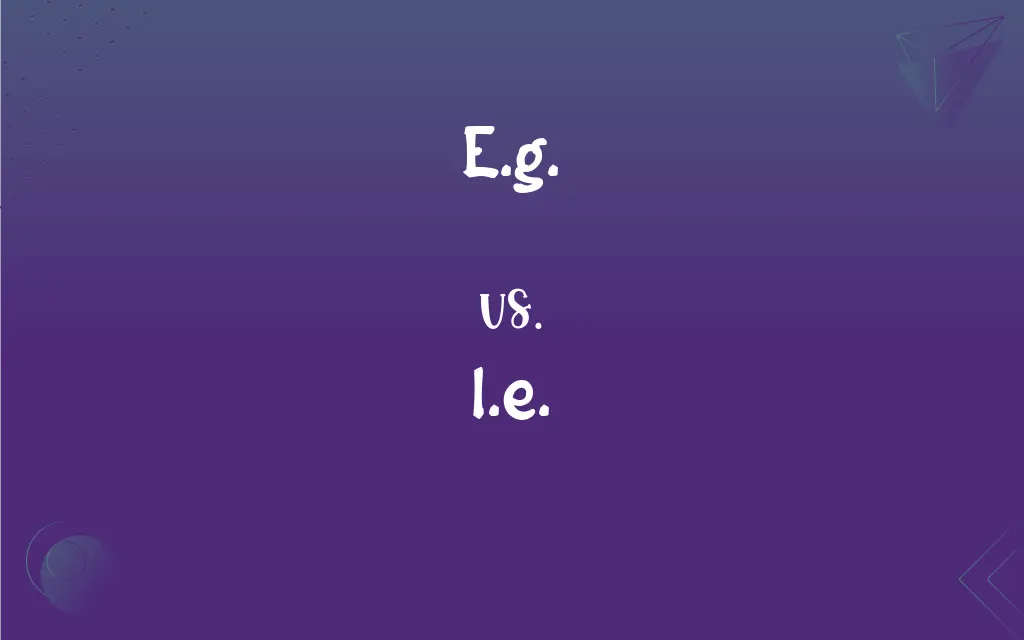E.g. vs. I.e.: What's the Difference?
Edited by Aimie Carlson || By Janet White || Published on March 22, 2024
e.g. means "for example," and i.e. means "that is" or "in other words," used to clarify or specify.

Key Differences
e.g. and i.e. are both Latin abbreviations used to provide clarification in English writing. e.g. stands for "exempli gratia," which means "for example." It is used to introduce one or more examples of the preceding statement. Conversely, i.e. stands for "id est," meaning "that is" or "in other words," and is used to provide a clarification or a definitive statement of the preceding idea.
When using e.g., the writer provides an example or a list of examples that illustrate the statement made. This does not mean the list is exhaustive; it merely shows some possibilities. For instance, when saying, "I enjoy outdoor activities, e.g., hiking, biking, and swimming," it suggests that these are just some examples of outdoor activities the writer enjoys. On the other hand, i.e. is used to specify or explain precisely what has been referred to in the statement. It narrows down the statement to a specific detail, such as in "I enjoy only solitary outdoor activities, i.e., long-distance running."
The use of e.g. implies that there are other examples or possibilities not mentioned, providing a broader scope to the statement. It indicates that the list is not comprehensive and other items could have been included. i.e., however, restricts the scope to the exact identity or explanation provided, leaving no room for additional interpretations or examples outside of what is specified.
In academic and formal writing, both e.g. and i.e. serve important roles in providing clarity and precision. e.g. is particularly useful when listing examples to support an argument or point, without limiting the scope of the statement. i.e. is crucial when a precise definition or clarification is necessary to ensure the reader's understanding is aligned with the writer's intent.
It is important to use e.g. and i.e. correctly to avoid confusion. Misusing e.g. in place of i.e. can lead to ambiguity, as the reader might expect additional examples when in fact a specific clarification or definition is intended. Similarly, replacing i.e. with e.g. can mistakenly suggest that a definitive statement is just one of many possibilities, which may dilute the intended specificity of the statement.
ADVERTISEMENT
Comparison Chart
Meaning
"For example"
"That is" or "In other words"
Purpose
To introduce examples
To clarify or specify
Implication
Suggests other possibilities exist
Indicates no other options are considered
Usage in a sentence
Followed by examples, not a complete list
Followed by a clarification or exact detail
Commonly confused with
Often mistaken as an exhaustive list
Sometimes used as if it means "for example"
ADVERTISEMENT
E.g. and I.e. Definitions
E.g.
Can precede a list of examples that illustrate a broader category.
She enjoys various art forms, e.g., painting and sculpture.
I.e.
Stands for "id est," which means "that is" or "in other words."
I'm a pescatarian, i.e., I don't eat meat but I do eat fish.
E.g.
Indicates that the provided examples are not exhaustive.
Many countries in Europe, e.g., France and Germany, have rich histories.
I.e.
Can be used in parentheses to provide a specific clarification.
Our goal is to increase efficiency (i.e., doing more in less time).
E.g.
Abbreviation for "exempli gratia," meaning "for example."
I love citrus fruits, e.g., oranges and lemons.
I.e.
Indicates a restatement or precise explanation of a term or idea.
She prefers to use renewable energy sources, i.e., wind and solar power.
E.g.
Used to introduce one or more examples.
There are many classic novels worth reading, e.g., 'Moby Dick' and 'Pride and Prejudice.'
I.e.
Often used to introduce a clarification that narrows down the subject.
He specializes in European history, i.e., the Renaissance period.
E.g.
Often used in parentheses to insert examples into a sentence.
He's skilled in many programming languages (e.g., Python, Java).
I.e.
Used to clarify or specify a statement.
The meeting is scheduled for the end of the week, i.e., Friday.
FAQs
When should I use e.g. in a sentence?
Use e.g. when you want to provide examples that illustrate your point but are not an exhaustive list.
Can I use i.e. to give examples?
No, i.e. is used to clarify or specify, not to list examples.
Are e.g. and i.e. interchangeable?
No, they serve different purposes: e.g. introduces examples, while i.e. provides clarification.
Do I need to use commas after e.g. and i.e.?
Yes, it's standard to follow both e.g. and i.e. with a comma in American English.
Can I use e.g. and i.e. in academic writing?
Yes, but ensure they are used correctly to maintain clarity.
Should I italicize e.g. and i.e.?
It's not required to italicize them, as they're well integrated into English.
What do e.g. and i.e. stand for?
e.g. stands for "exempli gratia" (for example), and i.e. stands for "id est" (that is/in other words).
Do I need to list multiple examples after e.g.?
At least one example should follow e.g., but more can be listed for clarity.
How can I remember the difference between e.g. and i.e.?
Think of e.g. as "example given" and i.e. as "in essence."
How do I avoid confusion between e.g. and i.e.?
Remember, e.g. = examples, i.e. = "in essence" or clarification.
How do e.g. and i.e. affect the tone of my writing?
Used correctly, they can add precision and clarity, enhancing the reader's understanding.
Can e.g. and i.e. be used at the beginning of a sentence?
While less common, they can be used at the start if followed by a clarifying statement or examples.
Are there alternatives to using e.g. and i.e.?
Yes, "for example" can replace e.g., and "that is" or "in other words" can replace i.e.
Is it okay to use "etc." after e.g.?
It's redundant because e.g. already implies that the list is not complete.
What's a common mistake when using e.g. and i.e.?
A common mistake is using i.e. when you mean to provide examples (e.g.).
Can I use e.g. and i.e. in informal writing?
Yes, but ensure their use adds clarity rather than confusion.
Can e.g. and i.e. be used in formal writing?
Yes, when used appropriately, they fit well in formal contexts.
Should "e.g." and "i.e." be followed by a list or a single item?
e.g. can be followed by a list or a single item; i.e. is typically followed by a clarifying phrase or sentence.
Is there a preferred position for e.g. and i.e. within a sentence?
They are typically used in the middle or at the end of sentences to introduce examples or clarifications.
How do I correctly punctuate sentences containing e.g. and i.e.?
Use a comma after e.g. and i.e., and ensure the sentence remains clear and grammatically correct.
About Author
Written by
Janet WhiteJanet White has been an esteemed writer and blogger for Difference Wiki. Holding a Master's degree in Science and Medical Journalism from the prestigious Boston University, she has consistently demonstrated her expertise and passion for her field. When she's not immersed in her work, Janet relishes her time exercising, delving into a good book, and cherishing moments with friends and family.
Edited by
Aimie CarlsonAimie Carlson, holding a master's degree in English literature, is a fervent English language enthusiast. She lends her writing talents to Difference Wiki, a prominent website that specializes in comparisons, offering readers insightful analyses that both captivate and inform.































































